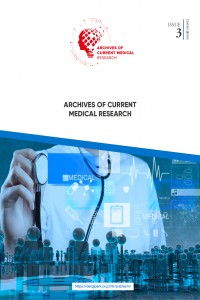Abstract
References
- 1. Gibson JAG, Yarrow J, Brown L, Evans J, Rogers SN, Spencer S, et al. Identifying patient concerns during consultations in tertiary burns services: development of the Adult Burns Patient Concerns Inventory. BMJ Open. 2019;9(12):e032785.
- 2. American Burn Association. Burn Referral Criteria; Available at: https:// ameriburn.org/wp-content/uploads/2017/05/burncenterreferralcriteria.pdf Accessed: 20.07.2021
- 3. Bettencourt AP, Romanowski KS, Joe V, Jeng J, Carter JE, Cartotto R, et al. Updating the Burn Center Referral Criteria: Results From the 2018 eDelphi Consensus Study. J Burn Care Res. 2020;41(5):1052-1062.
- 4. Aviv U, Berl A, Haik J, Tessone A, Harats M. Standardization of Burn Patients Transfer: Implementation of a Transfer Request Form to Israel’s National Burn Center. Isr Med Assoc J. 2020;11(22):700-703.
- 5. Yastı AÇ, Şenel E, Saydam M, Özok G, Çoruh A, Yorgancı K. Guideline and treatment algorithm for burn injuries. Ulus Travma Acil Cerrahi Derg. 2015 Mar;21(2):79-89.
- 6. World Health Organisation. Global burden of disease. Switzerland: World Health Organization Press, 2004: 1–160 (e-book). Available at: https://www. who.int/healthinfo/global_burden_disease/GBD_report_2004update_full. pdf?ua. Accessed: July 20,2021.
- 7. Vogt PM, Busche MN. Evaluation of infrastructure, equipment and training of 28 burn units/burn centers in Germany, Austria and Switzerland. Burns. 2011;37(2):257-64.
- 8. Van Yperen DT, Van Lieshout EMM, Nugteren LHT, Plaisier AC, Verhofstad MHJ, Van der Vlies CH, et al. Adherence to the emergency management of severe burns referral criteria in burn patients admitted to a hospital with or without a specialized burn center. Burns. 2021 Mar 1:S0305-4179(21)00059-0.
- 9. Brusselaers N, Monstrey S, Vogelaers D, Hoste E, Blot S. Severe burn injury in Europe: a systematic review of the incidence, etiology, morbidity, and mortality. Crit Care. 2010;14(5):R188.
- 10. The Official Gazette, 8 October 2019, Number:30912 Ministry of Health, Legislation about Burnt Treatment Units. Available at: https://www. resmigazete.gov.tr/eskiler/2019/10/20191008-1.htm.Accessed: July 20,2021.
Abstract
Background: In addition to being painful, burns cause aesthetic anxiety, causing patients to apply to the emergencies as soon as it occurs, and their first interventions are made in the emergency. In this study, the compliance with the guidelines in the consultations requested from the burn center and the referral of the patients to the center was evaluated.
Methods: Burn etiology, TBSA, burn depth, and area of adult patients were recorded, applied to our hospital’s emergency with burns in 2019 and 2020, and were asked for consultation from the burn center.
Results: Within two years, consultation was requested from the burn center for a total of 288 patients. Of the consulted patients, 73 (25.3%) were admitted to the center. When the evaluation was made between the patients who were hospitalized and not, the burn depth, etiology, and the percentage of TBSA were statistically significant.
Conclusions: Indications for referral and hospitalization to burn centers have been determined with specific clinical guidelines. A significant result that stands out in this study is that 215 out of 288 consultations requested from the burn center didn’t have an indication for hospitalization. With this study, the necessity of reconsidering the tendency to ask for a consultation has emerged. Emergency medicine physicians should be well-equipped with minor burn dressings as well as having knowledge about first response, referral decision and management. In this regard, if there is a burn unit/center in university hospitals or education hospitals, rotation of emergency medicine residents to burn treatment units should be discussed.
Keywords
References
- 1. Gibson JAG, Yarrow J, Brown L, Evans J, Rogers SN, Spencer S, et al. Identifying patient concerns during consultations in tertiary burns services: development of the Adult Burns Patient Concerns Inventory. BMJ Open. 2019;9(12):e032785.
- 2. American Burn Association. Burn Referral Criteria; Available at: https:// ameriburn.org/wp-content/uploads/2017/05/burncenterreferralcriteria.pdf Accessed: 20.07.2021
- 3. Bettencourt AP, Romanowski KS, Joe V, Jeng J, Carter JE, Cartotto R, et al. Updating the Burn Center Referral Criteria: Results From the 2018 eDelphi Consensus Study. J Burn Care Res. 2020;41(5):1052-1062.
- 4. Aviv U, Berl A, Haik J, Tessone A, Harats M. Standardization of Burn Patients Transfer: Implementation of a Transfer Request Form to Israel’s National Burn Center. Isr Med Assoc J. 2020;11(22):700-703.
- 5. Yastı AÇ, Şenel E, Saydam M, Özok G, Çoruh A, Yorgancı K. Guideline and treatment algorithm for burn injuries. Ulus Travma Acil Cerrahi Derg. 2015 Mar;21(2):79-89.
- 6. World Health Organisation. Global burden of disease. Switzerland: World Health Organization Press, 2004: 1–160 (e-book). Available at: https://www. who.int/healthinfo/global_burden_disease/GBD_report_2004update_full. pdf?ua. Accessed: July 20,2021.
- 7. Vogt PM, Busche MN. Evaluation of infrastructure, equipment and training of 28 burn units/burn centers in Germany, Austria and Switzerland. Burns. 2011;37(2):257-64.
- 8. Van Yperen DT, Van Lieshout EMM, Nugteren LHT, Plaisier AC, Verhofstad MHJ, Van der Vlies CH, et al. Adherence to the emergency management of severe burns referral criteria in burn patients admitted to a hospital with or without a specialized burn center. Burns. 2021 Mar 1:S0305-4179(21)00059-0.
- 9. Brusselaers N, Monstrey S, Vogelaers D, Hoste E, Blot S. Severe burn injury in Europe: a systematic review of the incidence, etiology, morbidity, and mortality. Crit Care. 2010;14(5):R188.
- 10. The Official Gazette, 8 October 2019, Number:30912 Ministry of Health, Legislation about Burnt Treatment Units. Available at: https://www. resmigazete.gov.tr/eskiler/2019/10/20191008-1.htm.Accessed: July 20,2021.
Details
| Primary Language | English |
|---|---|
| Subjects | Clinical Sciences |
| Journal Section | ORIGINAL ARTICLE |
| Authors | |
| Publication Date | September 22, 2021 |
| Submission Date | August 9, 2021 |
| Published in Issue | Year 2021 Volume: 2 Issue: 3 |
Archives of Current Medical Research (ACMR) provides instant open access to all content, bearing in mind the fact that presenting research
free to the public supports a greater global exchange of knowledge.


